
How to Restore from iCloud Backup (4 Easy Methods) [iPhone 17 Supported]
iCloud Backup
- Backup to iCloud
- 1. View Text Messages on iCloud
- 2. Backup/Extrac WhatsApp from iCloud
- 3. iCloud Drive, iCloud Sync & iCloud Backup
- Extract iCloud Backup
- 1. Access iCloud Backup Files
- 2. Retrieve Data From iCloud
- 3. Access and Download iCloud Backup
- 4. Top 6 Free iCloud Backup Extractor
- Restore from iCloud
- 1. Restore from iCloud Backup
- 2. Recover Photos from iCloud
- 3. Restore WhatsApp from iCloud
- 4. Restore iCloud Backup to iPhone
- 5. Restore Text Messages from iCloud
- 6. Restore Notes from iCloud
- 7. Restore WhatsApp from iCloud
- 8. Can't Restore an iCloud Backup
- 9. Retrieve Photos from iCloud Backup
- iCloud Backup Issues
- ● Manage/transfer/recover data
- ● Unlock screen/activate/FRP lock
- ● Fix most iOS and Android issues
- Start Backup Start Backup Start Backup
Nov 06, 2025 • Filed to: Data Recovery Solutions • Proven solutions
Dr.Fone Basic:
Better Control for Your Phone
Manage, transfer, back up, restore, and mirror your device
Losing data on your iPhone can feel overwhelming—whether it's caused by accidental deletion, a system crash, or even a misplaced device. Photos, messages, and contacts are too valuable to lose. Thankfully, iCloud backup provides a reliable safety net, allowing you to quickly recover essential files. But here's the good news: you don't always need a factory reset to restore from iCloud backup. With the latest iPhone 17, Apple has enhanced backup and recovery options, making it easier and faster to retrieve your data without wiping your entire device. This means you can now restore iPhone 17 from iCloud backup without resetting, keeping your current setup intact while still recovering lost files.
Backing up all of the content on iOS devices is made very easy by iCloud. But restoring the iPhone from iCloud backup is not as easy as it should be with iCloud. It depends on whether we want to restore the backup to a new device or restore some of the content on an iPhone in use.
In this article, we will discuss how we can restore an iPhone from iCloud during the setup process and how to restore the iCloud backup without having to reset the device. We will also look at several issues you may face while restoring the iCloud backup and how you can solve them.
Part 1. What is the official method to restore your iPhone from an iCloud backup?
Restoring data on your iPhone doesn't have to be complicated. Apple's official process to restore from iCloud backup is simple and user-friendly, ensuring you can quickly get your files back with minimal effort. With the new iPhone 17, Apple has made the recovery process even more seamless. Whether you're upgrading or fixing an issue, you can easily restore iPhone 17 from iCloud backup to access your photos, contacts, apps, and settings in just a few steps.
We want to restore the iCloud backup to a new iPhone or an iPhone in use, we need to make sure we have an iCloud backup file to restore. To backup iPhone to iCloud, go to iPhone Settings > Your Name > iCloud > tap on Backup Now. If you are using iOS 26 or earlier, go to Settings > Scroll down and tap on iCloud > Turn on iCloud Back and then tap on Backup Now.
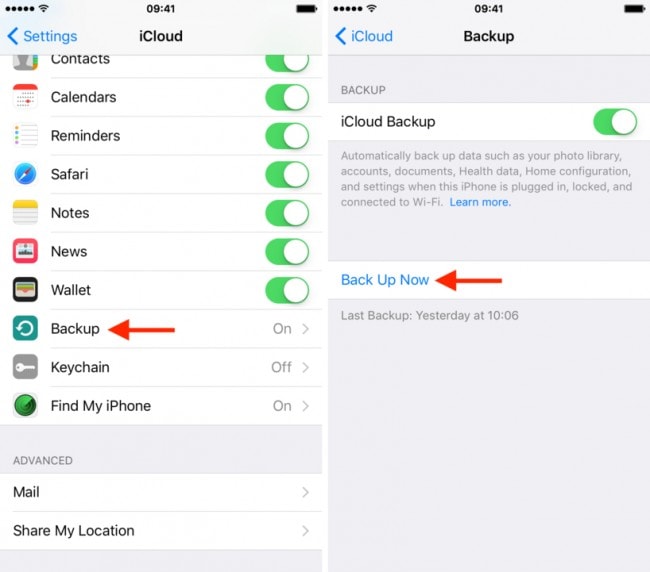
Now that we are sure we have the proper iCloud backup, let's see how to restore iPhone from iCloud.
1. How to restore a new iPhone from an iCloud backup?
If you've got a brand-new iPhone and wish to transfer data from your old device, setting up the new one from an iCloud backup is simple:
- Step 1 Turn on Your Device: Turn on your new iPhone and follow the on-screen setup instructions until you reach the 'Apps & Data' screen.
- Step 2 Select "Restore from iCloud Backup": During the setup process, choose the option to restore from an iCloud backup.
- Step 3 Sign in with Your Apple ID: Sign in to iCloud with your Apple ID to access your iCloud backups.
- Step 4 Choose a Backup: Select the backup you want to restore from the list, considering the date and size of each backup.
- Step 5 Wait for Restoration to Complete: Wait for the restore process to complete, keeping your device connected to Wi-Fi and a power source if necessary.
2. How to restore an iPhone in use from an iCloud backup?
For iPhones already in use, restoring from an iCloud backup means replacing current data with that from an older backup. So if you want to restore some content from iCloud backup, you need to erase your iPhone to set it up again. Follow the steps below to restore the iPhone from iCloud backup.
- Step 1: Open the Settings app and tap on your name at the top to open iCloud settings.
- Step 2: Tap 'iCloud' and then 'iCloud Backup'.
- Step 3: Switch on 'iCloud Backup' if it's not already enabled.
- Step 4: Tap 'Back Up Now' to make a new backup if needed.
- Step 5: Navigate to 'General' > 'Reset' > 'Erase All Content and Settings'.
- Step 6: Follow the setup instructions until you reach the Apps & Data screen, then choose 'Restore from iCloud Backup' and proceed with selecting the backup file.
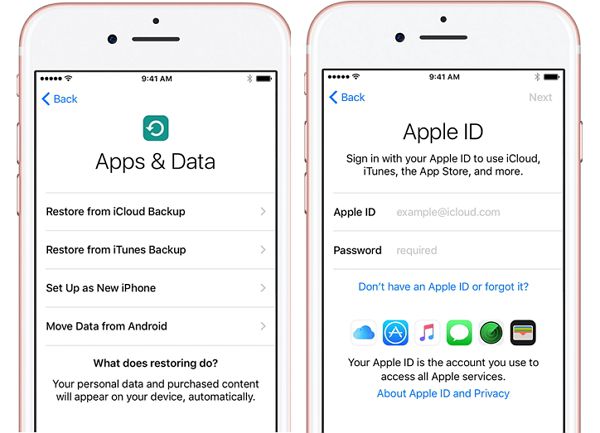
Keep in mind that when you restore from iCloud backup, all existing data on your device will be replaced by the backup content. If your backup isn't recent, you risk losing newer files and updates. On the iPhone 17, this process works the same way—restoring ensures your data is recovered, but it's crucial to maintain the latest iCloud backup for iPhone 17 to avoid losing important information like recent photos, messages, or app data.
Tips: Looking for an all-in-one mobile management software? Look no further than Dr.Fone App - the ultimate choice for all your needs:
- For iOS Users: Free up space with Smart Clean, remove any restriction including screen lock, iCloud activation lock, MDM, or Apple ID, and transfer data easily between devices with our all-in-one iOS solution.
- For Android Users: Bypass screen locks and FRP with our Android unlocker, change your location with one click, and repair damaged Samsung devices with ease.
Discover more possibilities for mobile management solutions with Dr.Fone App (iOS) and Dr.Fone App (Android). Don't miss out, try it now and revolutionize your smartphone experience.
Part 2. How to restore from iCloud backup without resetting?
For many iPhone users, performing a full factory reset feels unnecessary—especially if you only need to recover specific data. What if you just want to restore from iCloud backup without reset to retrieve a few lost contacts, messages, or photos? Erasing your whole device just to get back a small portion of data can be frustrating. With the advanced features of the iPhone 17, you now have smarter options to selectively recover information. Instead of wiping your phone, you can restore iPhone 17 from iCloud backup selectively, keeping all your existing files intact while retrieving only what you've lost.
A leading solution for iOS data recovery is Wondershare Dr.Fone, a trusted tool that lets you quickly recover either your entire data or specific files like contacts, photos, or messages. What makes it especially useful is its ability to selectively restore from iCloud backup or iTunes, giving you full control over what to bring back. For iPhone 17 users, Wondershare Dr.Fone offers seamless compatibility, making it easy to restore iPhone 17 from iCloud backup without losing existing data.
Wondershare Dr.Fone
The ultimate way to selectively restore the iCloud backup to iPhone
- Retrieve data directly from iTunes backup and iCloud backup.
- Support all iPhone models and the latest iOS fully!
- Preview, select, and restore data in original quality.
- Read-only and risk-free.
Here's how you can use it to restore from an iCloud backup without a reset:
- Step 1: Run Wondershare Dr.Fone on your computer and then select "iCloud Manage".
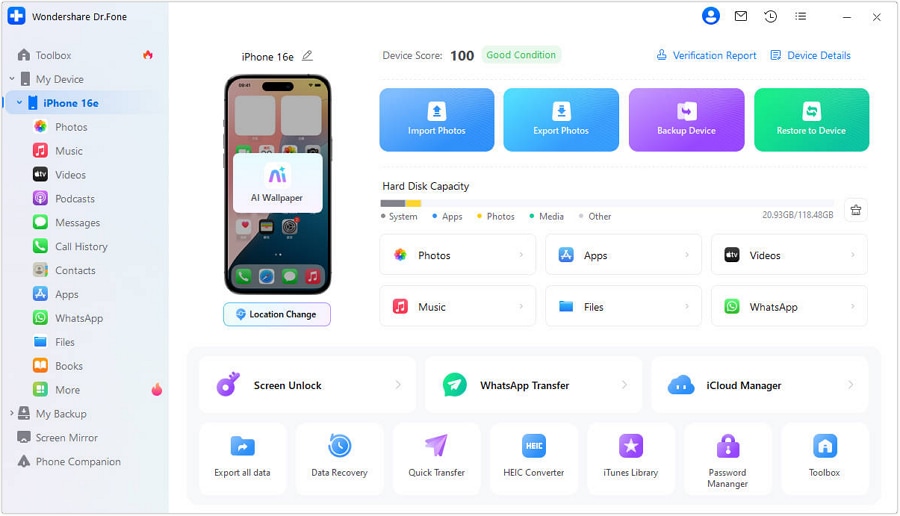
- Step 2: You will then be required to sign in to your iCloud account. After the signing, the verification code needs to be entered if you have turned on the two-factor authentication.
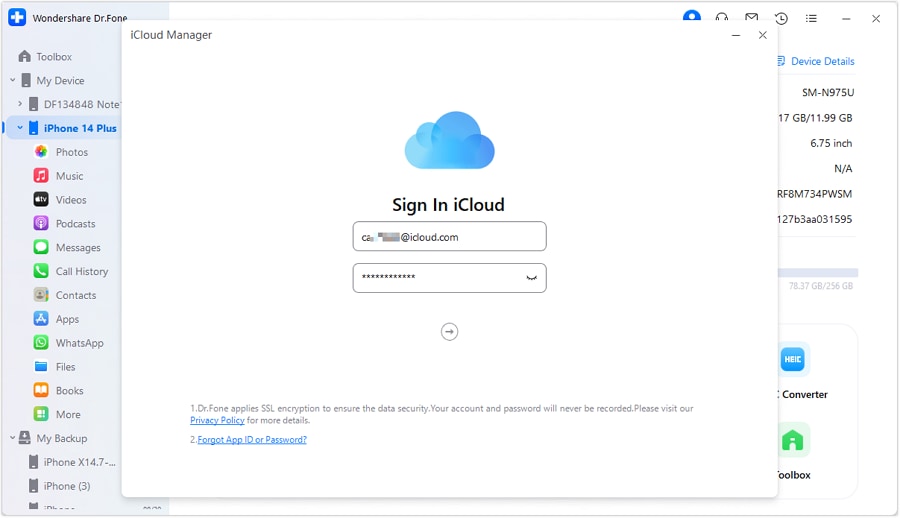
- Step 3: All your iCloud backup files associated with this account can be displayed now. Choose the files you want to restore and click "Restore to Device" to proceed toward the restoration.

- Step 4: Once the transfer is complete, Click Done to finish and access restored data on your iDevice.

Part 3. Restore from iCloud backup not working? Here's what to do
While restoring an iPhone is usually smooth, sometimes the process doesn't go as planned. In certain cases, your device may fail to restore from iCloud backup, leaving parts of your data missing or incomplete. Below, we highlight the most common problems and effective solutions to fix the iPhone won't restore error.
You get the error message, “There was a problem loading your iCloud backups. Try again, set up as a new iPhone or restore from iTunes backup.”
If you see this message, it generally means a problem with the iCloud servers. To mitigate this problem, you should check the iCloud system status.
Go to the webpage at http://www.apple.com/support/systemstatus/ and if the status is green, the servers are running just fine and the problem could be your own device's connectivity. Just wait a few hours and then try again.
"Photos and Videos fail to restore" Error: This can happen if the camera roll is somehow excluded from the backup section. You can check whether the iCloud backup has camera roll enabled. Here's how;
- Step 1: Open settings > iCloud and then Tap on Storage & Backup > Manage Storage.
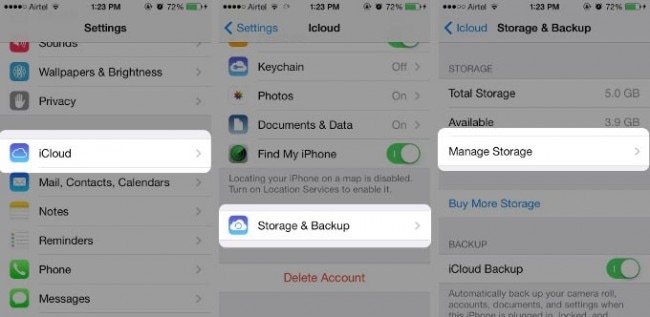
- Step 2: Select the device name, which is also the device backed up, and make sure that the Camera Roll is turned on. This will ensure that even the photos and videos are backed up. Wait a few hours and try again.
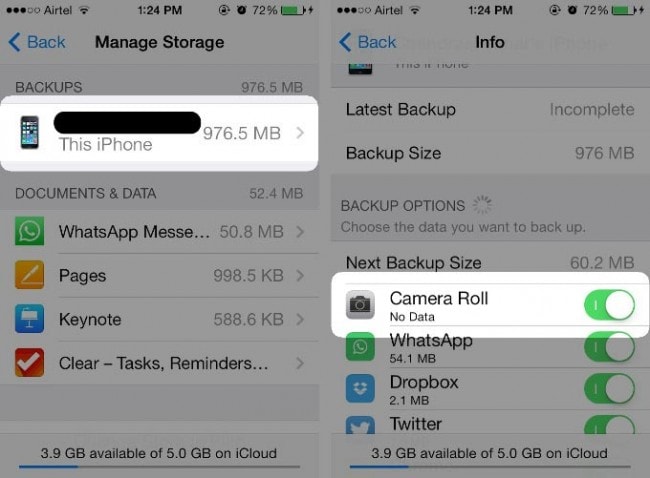
We hope you can restore your iCloud backup, although if you are experiencing problems with your backup, Wondershare Dr.Fone would be the ideal choice as it doesn't rely on iCloud servers.
Dr.Fone App
Your One-Stop Expert for Screen Unlock, Smart Clean, Data Recovery, Change Location, and Phone Management of Mobile Devices!
- Effortlessly unlock various locks on your device.
- Instantly free up storage space by smart clean.
- Rapidly recover different kinds of lost phone data and information.
- Easily changes GPS location on Android devices.
- Easily manage cluttered and private device content.
Part 4. Frequently Asked Questions (FAQs) about iPhone Backup and Restore
1. Why should you backup your iPhone?
Backing up your iPhone is crucial to prevent data loss in case of device theft, damage, or failure. Regular backups to iCloud or your computer ensure that your photos, apps, contacts, settings, and other important information can be easily restored.
2. How long does it take to restore from an iCloud backup?
The time it takes to restore from iCloud backup varies based on several factors, including the size of your backup, internet speed, and Apple's server status. Smaller backups may complete in just a few hours, while larger backups can take significantly longer—sometimes up to a full day or more.
3. Will restoring from an iCloud backup erase my data?
When setting up a new iPhone or after a factory reset, choosing to restore from iCloud backup will replace all current data on the device. That's why creating regular iCloud backups is essential—ensuring you can always recover and restore your most recent data.
4. Can I manually choose what to restore from an iCloud backup?
With the official method, you don't have the flexibility to choose individual pieces of data to restore; the entire backup will be restored. However, third-party tools like Wondershare Dr.Fone allow you to selectively restore texts, contacts, photos, and more.
5. Why does my iPhone say there's not enough space to restore from iCloud?
To restore from iCloud, you need to have enough free space on your device for the backup to fit. If you don't have enough space, you can delete content manually or use the selective restore feature of third-party software.
6. How do I restore my iPhone from a backup on my computer?
To restore your iPhone from a backup on your computer, follow these steps:
- Connect your iPhone to the computer you used for the backup.
- Open iTunes (for macOS Mojave and earlier) or Finder (for macOS Catalina and later).
- Select your iPhone when it appears in iTunes or Finder.
- Choose 'Restore Backup'.
- Pick the most relevant backup by looking at the date and size.
- Click 'Restore' and wait for the process to finish. Keep your device connected after it restarts and wait for it to sync with your computer.
7. How do I restore my iPhone to factory settings?
To restore your iPhone to factory settings, please do the following:
- Go to 'Settings' > 'General'.
- Scroll down and select 'Reset'.
- Tap 'Erase All Content and Settings'.
- Enter your Apple ID password if prompted.
- Confirm that you want to erase the device.
After the process is complete, your iPhone will restart as if it were new.
8. How can I restore from an iCloud backup after phone setup was already initiated?
To restore from an iCloud backup after you have already started setting up your iPhone, you'll need to erase your iPhone and start over. Here's how you can do it:
- Go to 'Settings' > 'General' > 'Reset'.
- Tap 'Erase All Content and Settings'.
- After the erase, you will have the option to start setting up your iPhone again.
- During the setup process, choose 'Restore from iCloud Backup'.
- Sign in to iCloud with your Apple ID.
- Choose a backup. Make sure it's the correct one by looking at the date and the size.
Make sure your iPhone stays connected to Wi-Fi and plugged into power after setup. This allows content like your apps, photos, music, and other information to continue downloading.
Conclusion
Restore from iCloud backup is usually straightforward, but knowing the right method is key. Whether you choose a full reset or a selective restore, the right tools and steps help you manage your iPhone data with ease. Stay patient, follow the process, and you'll have your device running smoothly again in no time.
We recommend using Wondershare Dr.Fone, a powerful and easy-to-use tool that makes it simple to restore from iCloud backup without losing existing data on your iPhone. With its intuitive interface and selective restore option, Dr.Fone lets you recover only the files you need—making it a secure and efficient solution for iOS data recovery.
Dr.Fone Basic:
Better Control for Your Phone
Manage, transfer, back up, restore, and mirror your device




















Alice MJ
staff Editor